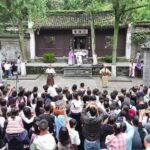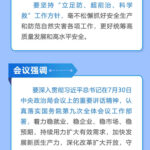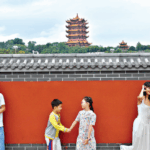During the National Day and Mid-Autumn Festival holiday, various regions introduced diverse cultural and tourism products, services, and activities, with the overall national cultural and tourism market remaining stable and orderly. According to calculations from the Ministry of Culture and Tourism Data Center, during the 8-day holiday period, domestic trips nationwide reached 888 million, an increase of 123 million compared to the 7-day National Day holiday in 2024; total domestic tourism spending reached 809.006 billion yuan, an increase of 108.189 billion yuan compared to the 7-day National Day holiday in 2024.
The combination of National Day and Mid-Autumn Festival boosted market activity. Red tourism sites across the country innovated exhibition methods and experience activities, with popular destinations including Jinggang Mountain in Jiangxi, Yan’an in Shaanxi, Orange Isle in Changsha, Hunan, and South Lake in Jiaxing, Zhejiang attracting large numbers of visitors. Citizens and tourists cultivated patriotic sentiments through their visits. Harvest and Mid-Autumn Festival themes were particularly popular, with Huangling Scenic Area’s “Autumn Harvest Culture Season” in Wuyuan County, Jiangxi, and Shanghai Planetarium’s “Moon Walk” being widely welcomed. The Hubei Provincial Museum and Shenyang Palace Museum hosted special Mid-Autumn Festival night events, while Changbai Mountain Scenic Area in Jilin introduced “Slow Travel Autumn Appreciation” hiking routes. Urban and rural consumption scenarios worked together effectively, with Changsha’s commercial districts in Hunan integrating shopping and performances, and Sandu Shui Autonomous County in Guizhou connecting long-table banquets with creative cultural markets through “Village Marathon” events. Inbound tourism experienced a surge, with ancient towns like Ciqikou in Chongqing and Xi’an’s Tang Dynasty Ever-bright City seeing increased numbers of foreign tourists, who particularly enjoyed cultural tours and shopping trips.
The integration of culture and tourism created innovative experience scenarios. Intangible cultural heritage experiences were highly popular, including Nanjing’s “Hundred Opera Lantern Festival” in Xinanli, Jiangsu, Tongling’s iron fireworks display in Anhui, and Luoyang’s ancient fire-spitting folk custom at Longmen Ancient Street in Henan. Beijing hosted the 9th China Opera Culture Week, featuring outstanding performances of Kunqu opera, Ganju opera, and Qinqiang opera. Holiday performances and exhibitions were particularly impressive, with the National Art Museum of China’s “National Freehand Brushwork Art Exhibition,” China Oriental Performing Arts Group’s dance drama “Eternal Palace,” and Beijing People’s Art Theatre’s drama “Thunderstorm” attracting large audiences. Technology-enabled new scenarios and experiences, including Shenzhen’s robot-themed streets in Longgang, Beijing’s robot-themed restaurants and 4S stores in Yizhuang, and Suizhou’s ginkgo valley water screen movie in Hubei, allowed visitors to experience the charm of “culture and tourism + technology.”
Public benefit and convenience measures stimulated consumption potential. More than 29,000 cultural and tourism activities were held nationwide, with over 480 million yuan in consumption subsidies distributed. The Beijing-Tianjin-Hebei “Scenic Spot Joint Ticket” promoted regional sharing of cultural and tourism resources. Government canteens and parking lots in Guangdong, Gansu, Chongqing, and other areas opened to tourists, while scenic spots like Laojun Mountain in Henan and Jincheng’s Situ Ancient Town in Shanxi offered affordable dining options, providing warm and thoughtful services for visitors. The Mogao Caves in Dunhuang, Gansu, launched a new generation of digital guide systems, while scenic spots like Hangzhou’s West Lake and Guizhou’s Huajiang Canyon Bridge implemented smart reservation and congestion warning technologies, providing real-time information for tourists and enhancing service efficiency through intelligent management.




